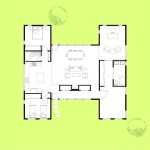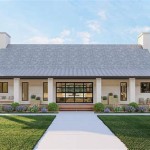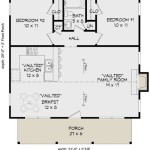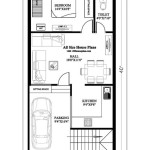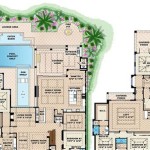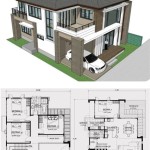House Plans 25 X 50: Maximizing Space and Functionality
The dimensions 25 feet by 50 feet represent a common footprint for numerous residential properties, both in urban and suburban environments. This rectangular shape offers a unique canvas for architectural creativity and efficient space utilization. House plans designed for these dimensions need careful consideration to ensure comfortable living, functional layout, and compliance with local building codes and regulations. This article aims to explore various aspects of house plans for a 25 x 50 foot lot, focusing on design considerations, zoning implications, and potential layouts.
Designing a house within these dimensions necessitates a strategic approach to maximize the available space. The narrow width poses challenges for natural light penetration and circulation, demanding innovative solutions to overcome these limitations. Architects and designers must carefully consider the placement of windows, the use of open floor plans, and the orientation of the house on the lot to optimize daylighting and ventilation. Additionally, storage solutions become crucial in smaller homes, requiring integrated and space-saving designs.
One critical early consideration in house planning is understanding local zoning regulations. These regulations dictate various aspects of construction, including setbacks (the minimum distance a building must be from property lines), height restrictions, and allowable building coverage. These factors directly impact the design possibilities and the overall size and shape of the house. Failure to comply with zoning regulations can result in costly delays and revisions, emphasizing the importance of thorough research and consultation with local authorities before commencing the design process.
Understanding Zoning Implications and Building Codes
Zoning regulations are not uniform across all municipalities; therefore, understanding the specific requirements for the location of the 25 x 50 foot lot is paramount. Setback requirements, for instance, determine how close the house can be built to the front, side, and rear property lines. These setbacks may vary depending on the specific zoning district and the type of road the property faces. Height restrictions limit the overall height of the building, potentially impacting the number of stories that can be built. Building coverage refers to the percentage of the lot that can be covered by the structure, including the house itself, driveways, and patios. Exceeding the allowable building coverage can lead to permit denials and construction delays.
Building codes, on the other hand, address the safety and structural integrity of the building. These codes cover aspects such as foundation requirements, framing standards, electrical wiring, plumbing systems, and fire safety measures. Adhering to building codes ensures that the house is built to a safe and durable standard, protecting the occupants from potential hazards. Local building departments enforce these codes through inspections throughout the construction process. It is essential to consult with a qualified architect or engineer to ensure that the house plan complies with all applicable building codes.
Furthermore, accessibility requirements, as mandated by the Americans with Disabilities Act (ADA) or similar local regulations, may need to be considered, especially if the house is intended for individuals with disabilities or older adults. These requirements can affect the design of doorways, hallways, bathrooms, and other features, ensuring that the house is accessible and usable by everyone.
Optimizing Space with Layout and Design Strategies
Given the limited dimensions of a 25 x 50 foot lot, effective space planning is crucial for creating a comfortable and functional living environment. Open floor plans, which combine living, dining, and kitchen areas into a single, large space, can create a sense of spaciousness and improve natural light distribution. Eliminating interior walls allows for better flow and flexibility, making the house feel larger than it actually is.
Vertical space utilization is another key consideration. Building upwards, rather than outwards, can significantly increase the living area. A two-story or multi-story design allows for the creation of bedrooms, bathrooms, and other private spaces on the upper floors, freeing up the ground floor for living and entertainment areas. Careful planning of staircases is essential to minimize their footprint and maximize usable space. Spiral staircases or compact stair designs can be effective solutions in smaller homes.
Storage solutions should be integrated into the design from the outset. Built-in cabinets, shelves, and drawers can maximize storage capacity without taking up valuable floor space. Utilizing vertical space for storage, such as tall cabinets and shelving units, can also be beneficial. Under-stair storage is another often-overlooked area that can be effectively used for storing items such as coats, shoes, or household supplies. Multi-functional furniture, such as sofa beds and storage ottomans, can also help to maximize space and versatility.
The placement of windows is also crucial for maximizing natural light and ventilation. Large windows or strategically placed skylights can bring ample daylight into the interior, reducing the need for artificial lighting. Operable windows allow for natural ventilation, promoting air circulation and reducing reliance on air conditioning. The orientation of the house on the lot should be considered to optimize solar gain in the winter and minimize heat gain in the summer.
Exploring Different House Plan Approaches
Several different house plan approaches can be adapted to the 25 x 50 foot footprint, each with its own advantages and disadvantages. A traditional layout might include separate living, dining, and kitchen areas, along with bedrooms and bathrooms on the upper floors. This approach can provide a sense of privacy and separation between different areas of the house. However, it may also result in a more cramped and compartmentalized feel.
A modern or contemporary layout often emphasizes open floor plans and clean lines. This approach can create a more spacious and airy feel, with better flow and connectivity between different areas of the house. Large windows and minimalist design elements are often incorporated to maximize natural light and create a sense of openness. However, an open floor plan may not be suitable for everyone, as it can lack privacy and create noise issues.
A loft-style layout can be another option, particularly for single individuals or couples. This approach typically involves a large, open space with minimal interior walls. Sleeping areas and other private spaces may be located on a mezzanine level, overlooking the main living area. Loft-style layouts can be very stylish and flexible, but they may not be suitable for families with children or individuals who require a lot of privacy.
Another consideration is the inclusion of outdoor spaces. A small backyard or patio can provide a valuable outdoor retreat, extending the living area and providing a space for relaxation and entertainment. A rooftop deck can also be a possibility, offering stunning views and a unique outdoor space. However, the inclusion of outdoor spaces will depend on the specific zoning regulations and the orientation of the house on the lot.
Choosing the right house plan for a 25 x 50 foot lot involves careful consideration of various factors, including zoning regulations, space optimization strategies, and personal preferences. Consulting with a qualified architect or designer is highly recommended to develop a house plan that meets individual needs and maximizes the potential of the available space. By carefully planning the layout, utilizing space-saving solutions, and optimizing natural light and ventilation, it is possible to create a comfortable and functional home within these dimensions.
The selection of materials and finishes also plays a significant role in the overall aesthetic and functionality of the house. Durable and low-maintenance materials can reduce long-term costs and simplify upkeep. Energy-efficient windows, insulation, and appliances can help to reduce energy consumption and lower utility bills. The use of sustainable materials and practices can also contribute to a more environmentally friendly home. The interior design should complement the overall architectural style and create a cohesive and inviting atmosphere.

25x50 House Plan Home Exterior Floorplan

Plan 25 X50 Plot Area 1250 Sqft

25x50 Affordable House Design Dk Home Designx

25x50 Houseplan Floor Plan House Map Line

25x50 House Plan

25 50 House Plan East Facing With Vastu Architego

25x50 Square Feet House Design 1250 Sq Ft Home Plan Dmg

25x50 House Plan With Interior East Facing Gopal Architecture

25x50 House Plan 5 Marla Map North Facing

25x50 House Plan Southwest Facing 1250 Square Feet 3d Plans 25 50 Sq Ft 2bhk 3bhk South West As Per Vastu

